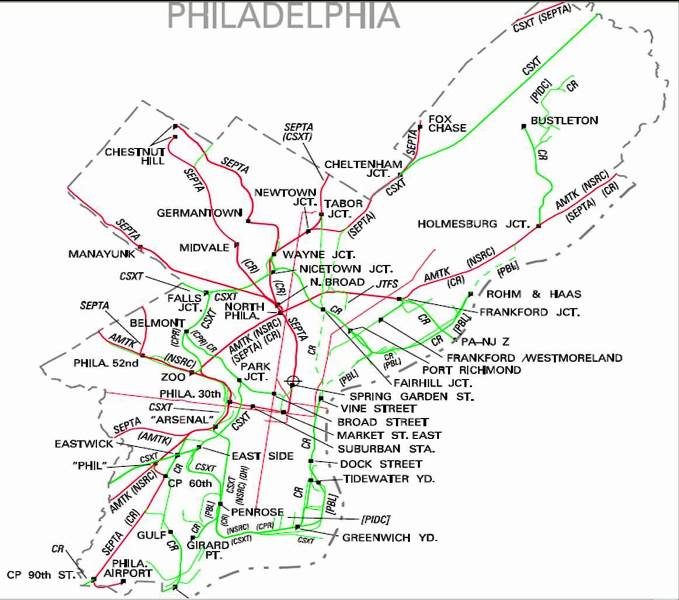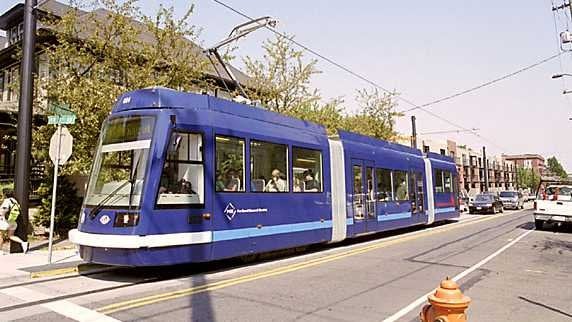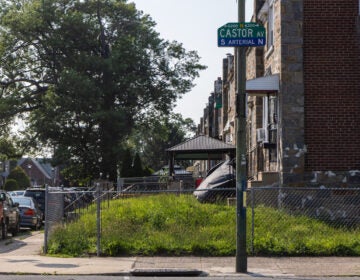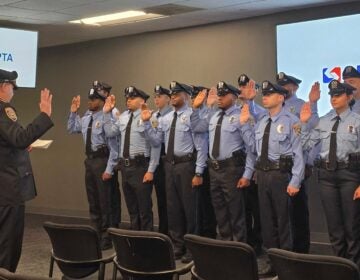Gauging right waterfront rail choice
Nov. 19
By Anthony Campisi
For PlanPhilly
What a difference 6 inches makes.
As the Delaware River Port Authority goes ahead with plans for a waterfront light rail line, it will have to decide the track size, or gauge, on which cars will run.
Though the decision seems small, it may have far-reaching implications on cost and compatibility with the existing SEPTA trolley network.
The DRPA has two choices going forward: It can run cars along a standard rail gauge, with tracks 4 feet 8 ½ inches apart, or it can operate along the Pennsylvania trolley gauge, with tracks separated by 5 feet 2 ½ inches.
Though no firm decision had been made, the DRPA is “leaning toward” using the standard gauge, according to a spokesman, in large part because the Belt Line Railroad — a freight line near the Delaware along which the light rail line would run — uses standard gauge tracks.
This means that the light rail line would run independently from the existing SEPTA trolley network, which uses the wider gauge, preventing a future extension of the Route 15 trolley down the river.
While this may limit operating flexibility in the future, Chris Jandoli of Parsons Brinkerhoff, the consulting firm hired by the DRPA to help develop the project, argues that a standard gauge line will make it easier for the line’s operator to purchase light rail cars because “it’s the common gauge that’s used around the world.”
Current plans call for standard gauge cars similar to ones operated in Portland and Seattle.
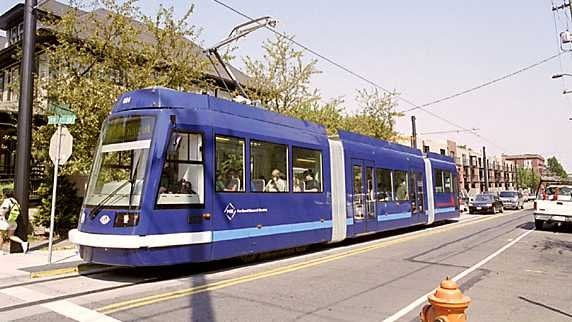
Doing this might forestall other potential cost savings, however.
SEPTA will be purchasing new trolley cars to replace its existing Kawasaki fleet around the time the new line is supposed to go online in 2016. The trolley and Delaware River purchases could be combined to save money, according to Adam Krom, a transportation planner and vice chairman of transit for SEPTA’s citizen advisory committee.
Assuming SEPTA operates the proposed line, using a single type of car throughout its system could cut down on training costs because workers would have to be trained to operate and maintain fewer types of vehicles.
Using the same cars might also save SEPTA money because it could perform maintenance and store the cars at the same facilities, Krom said.
At the same time, using the same vehicles could potentially provide West Philadelphians a one-seat ride to the waterfront by allowing SEPTA the flexibility to extend the Route 15 down the river. Current plans call for a transfer between the Route 15 and the new line at the Girard Avenue Market-Frankford El stop.
Though ridership patterns might not justify a one-seat ride from the Philadelphia Zoo to the waterfront, “this is essentially about enabling options” to allow SEPTA to easily alter its routes in the future, according to Gregory Krykewycz, a senior transportation planner at the Delaware Valley Regional Planning Commission.
Though Jandoli admitted the benefits of a one-seat ride, he said that the envisioned “cross-platform transfer” would be an easy one for riders to make because they would be able to disembark from one car and wait for another to pull up at the same platform.
“I’m not sure that the benefit of this [one-seat ride] is as great as its being presented,” he said.
At the same time, he questioned whether the increased flexibility provided by wide gauge tracks was worth the added hassle and cost of construction.
Because 50 to 60 percent of the right of way is currently built to standard gauge specifications along the Belt Line, it doesn’t make sense to go back and retrofit the Belt Line tracks to run wider cars, which would require that railroad’s approval, Jandoli said.
Adding a third rail to widen the tracks would require moving concrete islands surrounding the tracks on Columbus Boulevard, he said, though he added that the DRPA hasn’t yet analyzed how much doing that would cost.
The Belt Line hasn’t been approached about adding a third rail but isn’t necessarily opposed to it, said trustee George Woodward, adding that the railroad is “very supportive” of plans to improve public transit along the waterfront.
Krykewycz said that a cost analysis is important when making a smart decision on track gauge.
“It’s not a slam dunk one way or another,” he said. It all comes down to whether projected savings outweigh the cost of retrofitting the existing rail line.
The calculation gets more complex because the DRPA hasn’t yet decided whether to push for building a second pair of tracks along Columbus Boulevard. Though adding tracks would increase costs, require Belt Line approval and could impact traffic flows, it would allow the DRPA to decrease headways by allowing more cars to operate at the same time while traveling in opposite directions. It would also provide the DRPA with the opportunity to introduce an extra rail to widen the gauge — while still keeping the standard gauge alignment for future freight traffic.
But this decision, along with a final ruling on track gauge, isn’t expected until after the DRPA conducts its engineering studies.
It’s “one of the multitude of engineering issues that were tackling,” Jandoli said.
Contact the reporter at campisi.anthony@gmail.com
WHYY is your source for fact-based, in-depth journalism and information. As a nonprofit organization, we rely on financial support from readers like you. Please give today.



